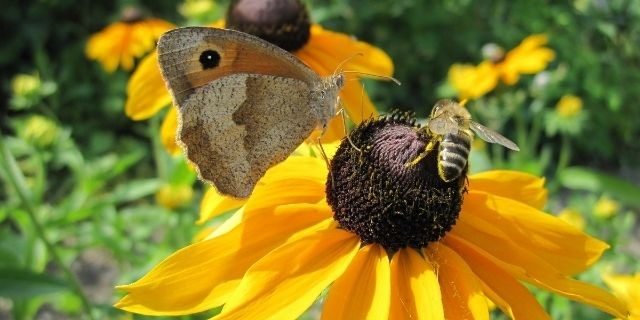21
Dec
Survey Technique Increases Agricultural Resiliency and Protects Pollinators; Higher Species Diversity in Organic

(Beyond Pesticides, December 21, 2022) Imagine plucking a flower and being able to find out every insect that recently visited that plant. Utilizing cutting-edge metabarcoding techniques, a team of Danish researchers has made that possibility a reality. By evaluating the environmental DNA (eDNA) left behind by insect pollinators alongside visual assessment surveys, a new study is providing an innovative way for farmers to improve pollination and protect on-farm biodiversity. Ultimately, study author Lene Sigsgaard, PhD, of the University of Copenhagen believes that, “With more knowledge of the pollinators in apples and other crops, we can begin to provide tailor-made flower mixes for individual crops, and improve our knowledge on the value of the surrounding landscape for wild pollinators.”
Scientists focused on four different apple orchards throughout Denmark, three of which utilize pesticides (though only one sprayed during the study period), and another following organic practices. For each orchard, five apple flowers were collected from four separate rows. These flowers were then brought to the laboratory from DNA extraction. Scientists also conducted visual monitoring, whereby an observer stood between two orchard rows and recorded all flower visitors within roughly eight feet of themselves.
The two methods of observation provide somewhat differing, yet complimentary results. Certain insects, such as hoverflies and hymenoptera (bees, wasps, ants), are not detected through eDNA, but are identified visually. Conversely, blattodea (cockroaches, termites) insects are not identified visually but found to be present through eDNA barcoding. eDNA is able to trace certain insect pests, and other flower visitors more active at night that visual monitoring would likely miss. However, timing of eDNA flower collection appears to impact the eDNA traces left behind, as certain pollinator species like bees and wasps are missed because flowers were collected in early morning prior to insect pollination. While eDNA shows value as a supplemental monitoring tool, visual monitoring provides more information on abundance.
“A high level of insect biodiversity protects an environment against certain threats, therefore monitoring these levels is necessary to see if and when intervention is needed,” says Nerea Gamonal, first author from the University of Copenhagen, Denmark. “Our study showed that eDNA adds a lot of value when compared against visual collecting techniques. This isn’t to say that visual census is unnecessary, in fact having an understanding of the insects in an area from observational techniques can provide prior knowledge of the specific community being assessed, making it a valuable complementary tool.”
Although not specifically investigated in this study, combined survey results also find that the organic apple orchard contains the highest richness of insect species. “The exciting thing about this study is that it can have an immediate, real-world impact on agricultural systems. The results and techniques in our study can be used to inform management practices such as the type of pest control used, the orchard design, and what additional floral resources surround the crops,” said Dr. Sugsgaard.
Real-time sampling eDNA sampling can provide a snapshot of insect visitation and help identify ecological alterations to address problematic pests, for instance, as opposed to approaches that rely on synthetic inputs like hazardous pesticides to correct natural imbalances. “Understanding how we can work with the environment, such as improving the surrounding landscape to attract beneficial insects, can help cross-pollination and lead to crops becoming more resilient against climate change. We hope this research can help our society become as environmentally friendly as possible, protecting our biodiversity, food sources and livelihoods,” says Physilia Chua, PhD, study co-author.
Knowledge of insect and pollinator visitation will be an increasingly important aspect of crop production in a progressively more precarious world. Earlier this year, research showed that for certain crops like watermelons, insect pollination, not pest pressure, is the most critical determining factor for yields. By delving into the details and rejecting a simplified, one-size-fits-all approach to agricultural production, farming can become a critical part of restoring, or in the least maintaining, natural balance and biodiversity.
Regenerative, organic farming practices have shown time and time again to be the best method of protecting biodiversity, ensuring on-farm sustainability, and meeting the challenges of a changing climate. For more information on the benefits of this approach, watch the recent talk from Rodale Institute’s Chief Operations Officer Andrew Smith on Organic Agriculture for Climate Mitigation.
All unattributed positions and opinions in this piece are those of Beyond Pesticides.
Source: Environmental DNA, PhysOrg (Wellcome Trust Sanger Institute press release)











Unless we protect bees and ban toxic pesticides (there are some really bad ones that affect bees exponentially), then we will be in deep trouble. Our food supplies will be effected and our range of produce reduced drastically. Is it worth it??
December 21st, 2022 at 4:54 pm